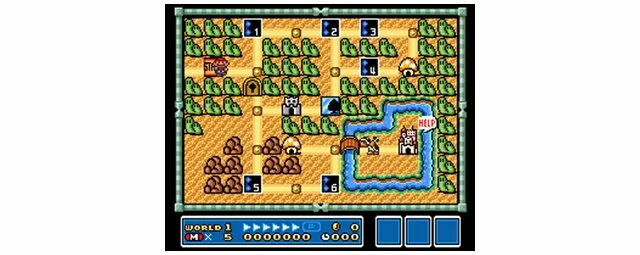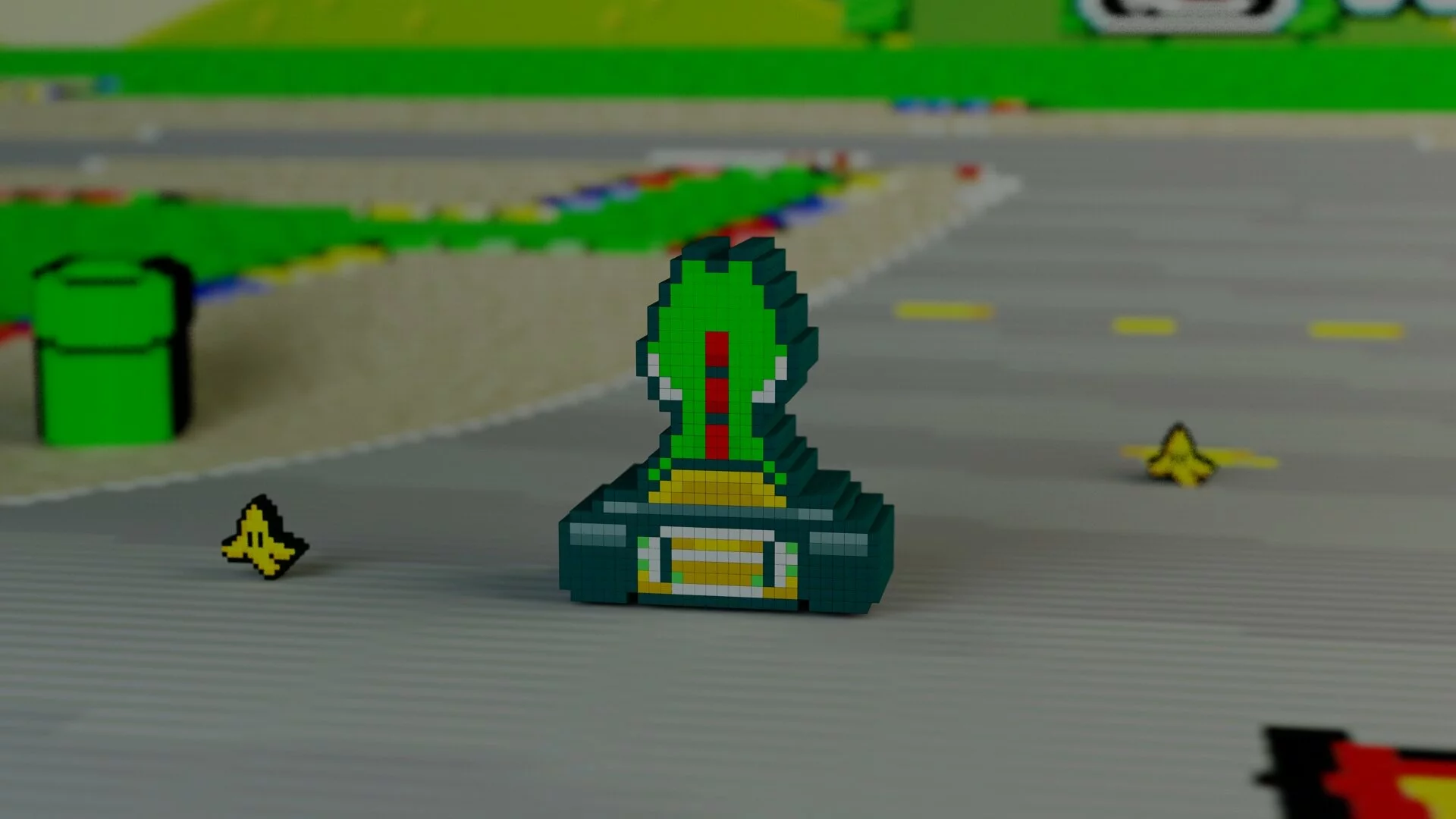Despite the time and technological advances since the days of Donkey Kong much of what is seen in the Mario of 1981 forms the basis of the character today…
Caveat – This is just an opinion.
This ‘Jumpman’ as he was then known had the task of rescuing his girlfriend from an ape. To succeed the player had to time and control Jumpman’s movements, jumping from platform to platform or over objects such as those now infamous barrels.
The game was revolutionary. It had four screens of action making it the biggest videogame ever produced. It was the first example of a complete narrative told in videogame form making use of cut-scenes to advance the plot. It also garnered unprecedented popularity, providing the financial foundations for Nintendo to create their American headquarters.
Jumpman, made up of a mere 16×16 pixels evolved into Super Mario and as a franchise he went on to shift hundreds of millions of units of gaming gold on various Nintendo systems across the globe. Super Mario has come to mean super sales and with Nintendo’s vertically integrated business ensuring their mascot’s profile remains high, this pattern will continue to be the case.
Shigeru Miyamoto designed Jumpman as carpenter who was “neither handsome nor heroic”. Mario’s origins were as a blue-collar, working class guy and in a world where the majority of avatars were either vehicles or extreme killers, here was an ‘ordinary’ character designed for the player to identify with.
What were seen as graphical restrictions were now to be used in helping develop this character. He was given a moustache to separate his nose from his face, overalls so arm movements were easily noticeable and a cap so that the complicated animation of hair could be disregarded. Engineers taught Miyamoto that it was important to distinguish the body so it would be clearly visible on a videogame screen, giving further reason behind Jumpman’s bright and distinctive red and blue clothing.
From the beginning Mario’s design revelled in being an original creation intended purely to extenuate the highest degree of character across to the player given the format’s obvious limitations.
Two years later saw the release of Mario Bros. (1983) and since Donkey Kong, Mario had adopted both the name and profession that we recognise of him today. More character was now instilled as the gameplay actually related to Mario’s job as a plumber. It was his task to exterminate the various pests that exited from the radiant-green sewer pipes at each corner of the screen. In many cases he did so using what became his trademark trait of jumping on the head of the enemy.
In 1985 Mario came of age (for the first time) and Super Mario Bros. (1985) was released for the Nintendo Entertainment System. This became the biggest selling game of all time (largely down to being bundled in with the N.E.S. hardware) having sold 40.24 million units. With more people having played this iteration than any other, one could say that the character found in Super Mario Bros. was the definitive Super Mario. As such, from here we will start to identify who and what is Super Mario.
Mario found himself in the Mushroom Kingdom and it was the player’s objective to negotiate him through the levels in a bid to rescue the Princess from the hands of Bowser, the King of the Koopas. It was the first original console game in this genre to feature smooth-scrolling levels, which made it a landmark in home-video gaming. When people played Super Mario Bros. they travelled to a world where nothing similar had ever been realised before. It was not just the technology of the game that astounded players but also the design as it was still the norm of the videogame market to be dominated by shooting and mass destruction. Miyamoto instead created a world that borrowed freely from folklore, literature and pop culture such as warp zones from Star Trek and empowering mushrooms from Alice in Wonderland. As a game Super Mario Bros. was completely unique and the beacon that conveyed these radical new feelings to the player was Mario.
Mario now had somewhat of a split personality. On face value he had been developed into an unremarkable, everyday plumber fromBrooklynhowever, as an accompaniment to that he was now the leader of a brand new 8-bit living room invasion that involved an entirely fresh way of thinking and living (and not just a Nintendo Entertainment System!). He was the bringer and guide to the next generation’s brave new world; as a character Mario may be a plumber but as a videogame character he was a revolutionary.
Game developers desperately clambered to get their slice of the profits seen with Super Mario Bros. and many attempted to clone the Mario formula by creating their own side-scrolling platform adventures. Some games were of a high quality however they would never escape the fact that the game and its character with their unique abilities and world would only ever surmount to Super Mario Bros. but with a minor variation. Although the platform game mechanic had since become the gaming norm, this only served in fuelling the desire for the arrival of the next significant platform game in the shape of the next one with the character of Super Mario in it.
The structure and story of the games stayed fundamentally the same for both Super Mario 3 (1988) and his 16-bit escapade, Super Mario World (1990). With the advances seen in graphical capabilities, Mario was starting to refine exactly how he looked. Of course the essential ingredients from Jumpman were still well pronounced however one must understand that from that fairly abstract figure that featured in Donkey Kong, Miyamoto could have moulded Mario into a distinctly different design when compared to the one that we take for granted today.
It was a choice to portray Mario as unrealistic. Super Mario World saw his in-game interpretation resemble the cartoon-like figure that had featured on promotional material and the boxart for years. The most important reason for this gradual move was because Mario’s market was children. When compared with fully grown animals or humans, babies have large heads and eyes with respect to their body size. Miyamoto exploited this feature and applied it to Mario to create a ‘cute appeal’ that was specifically aimed at younger gamers. For Mario this led to a further identity crisis; he may be a mature and experienced adult but he is also a child. This did however help to make sense of the strange world in which he inhabits.
“To us adults a chair is a chair, but to the child it is also many other things; a carriage, a house, a dog…The adult forces himself to remove and hide symbolism whereas the child immediately sees symbols, he cannot act other than in a clearly symbolic way.”
Nothing has to be accepted on a literal level as our avatar in this world is seemingly an adult that has regressed into a childlike form (with a child’s eyes). The games we play with Mario could be a visual insight into the daydreams of a Walter Mitty-esque plumber. It could be a symbolic interpretation of his own life; stuck in an unfamiliar world not of his own, charged with a nearly impossible mission, doomed to perish sooner or later yet free while he lives to grow and learn. It could be seen as a subconscious yearning to return to his infancy where death had no reality, money had a less threatening significance and new adventures awaited him with each passing day.
Mario is a symbolic character in a symbolic world that is completely open to the player’s interpretation (and not just with their joypad). So on one hand we see a plumber that rides dinosaurs and fights evil turtles but on the other we may catch a crude, bright, hypnotic reflection of our own lives.
Super Mario 64 (1996) saw Mario fully realised in three-dimensions. He was 15 years old and this game was the character’s true coming of age. He was again a revolutionary. From the moment Super Mario 64 was released it established a new archetype for the ‘platform’ genre. Much like 1985, copycats were sprouting continuously but again they could only ever be clones; it was Mario that was significant and he now had nostalgia on his side.
To accommodate for three dimensions, the game mechanic needed a complete overhaul. Of course it was still Mario’s duty to rescue the Princess however the traditional, linear obstacle course based levels were now replaced with vast worlds in which the player completed multiple and diverse missions, with an emphasis on exploration. With each completed mission Mario would earn a power star and with enough of these he could open new doors, explore new worlds and collect new stars. This new mechanic helped to highlight a lot of the appeal of Mario over the years.
Mario is a character that is attractive because of his increasing degree of freedom and choice. Initially players were amazed by the smooth-scrolling freedom of movement that Super Mario Bros. offered however this was easily surpassed by Super Mario Bros. 3. Now Mario could travel in any direction; he could fly and with that the screen could scroll horizontally, vertically and diagonally backwards or forwards often revealing multiple ways to complete the same level. Super Mario Bros. 3 also introduced an overworld map screen to each of its seven worlds where the player would select which stage they wanted to play through. This extra freedom of choice further empowered the players as they discovered secret pathways to avoid levels or gain extra items. They could now plan their route to Bowser’s castle rather than merely traversing their way to it.
With Super Mario World this planning was further increased as the entire game became connected by one consistent overworld map. Players often had to backtrack to previous locations in order to find an item to progress and the choice of exits and ways of completing each level had increased significantly offering a further incentive to explore every last inch they could. The different power-ups that Mario acquired throughout had also changed to encourage exploration; since the mushrooms, fire-plants and invincibility stars of Super Mario Bros. he now had experienced a frog suit (to aid swimming), a raccoon suit, a cape (both to glide) and a device that made him inflate and float like a balloon amongst others.
With Super Mario 64 players had three-dimensions to explore unrestricted by the time-limit that was seen in the previous versions. The overworld became Princess Peach’s castle and grounds and it was integrated into the actual game engine with the enclosed ‘stages’ now being accessed by jumping though magic paintings found scattered throughout. Within each world the player could collect 7 power stars one at a time and to a large extent, in any order they desired. This became the pinnacle of what the Mario games were building and evolving toward from the beginning. Super Mario 64 combined apparently open-ended exploration with a continual and clear direction. Players always have a lot to do but they are given a lot of choice about which parts of the world they work on and which stars they go for. The game avoids a lot of the ‘what’s-on-the-next-screen’ feel of side scrolling games by giving the player this extra degree control. With Super Mario 64 players spent much of their time deciding what they wanted to do next rather than trying to get unstuck or finding something to do.
The narrative thread still binds the game’s events together and drives players toward the completion of the game however it never impinges on the gameplay. Whatever choice is carried out to further the playing experience is always made by the player. If you get stuck on a particular task, you can try something else and return later. Even if you have enough stars to confront Bowser, it is still your choice whether or not to do so. Long after the final Bowser has been defeated and Mario’s personal quest is over, the player has the option to continue in a bid to find the potential 50 powers stars that still remain in the world. Rather than being the player’s guide, Mario becomes more of the player’s tool in navigating this world. As very little desire is shown of where to go, what to do and in what order to do it, it is not Mario that is demanding a certain character from the player but instead it is the player that demands a certain character of Mario.
Mario has always been a subjective, player driven character. He operates with a minor, simple set of controls which work at all times. Simple though the controls are, they have become increasingly expressive, allowing for rich interaction through simple movement and a small selection of jumping moves. By offering a very limited set of actions, but supporting them completely with very predictable physics and outcomes, the world is made real for the players.
The solidarity of Mario’s world makes players feel more connected to, or responsible for their actions and this is crucial for any successful interactive experience. When players attempt to do something and it goes wrong (or right for that matter), they are likely to realise why it went wrong.
A player’s input and intention are the biggest driving force behind Mario’s character. The player may take the choice to make Mario a greedy coin-hunter or a pacifist conflict avoider (even Bowser could be defeated without confrontation until Super Mario Bros. 3), an explorer or a ‘wam-bam’ level completer. Intention can operate at each level, from a quick plan to cross a falling bridge to a multi-step plan, like finding all the red coins. It is then down to the player’s input to demonstrate how successful Mario was in carrying out this part of his narrative.
It is language that is normally the major reflection of a character’s personality. As a result of Mario not verbally communicating or responding to any events that take place, he has no opposing emotions to that of the player. His intentions are the same, his feelings are the same; the player’s loss is his loss and with every success the player beams their own pure, raw happiness into his little, red-capped sprite.
Only with the advent of his 64-bit adventure did Mario actually say his first words however, Miyamoto was still careful to insure he remained a character that did not give too much away so that the shared emotional connection between player and character could remain. His vocabulary was limited to a few choice intonations and utterances that would culminate to see Mario become a friendly Italian-American stereotype. This was the first time that any real weight had been put into the games to emphasize the design-driven character of Mario, the Italian-American plumber. One could argue a case that this solid, non-subjective part of Super Mario’s character also contributed to his success.
When the Nintendo of America staff were ‘translating’ Donkey Kong they noticed the resemblance between Jumpman and their landlord Mario Segali, and so from that point on Jumpman became Mario. In Jumpman I believe there was more than just his big moustache that convinced them that an Italian-American personality would suit the character.
The Italian-Americans were slow to represent their own culture to the American public. Many of the immigrants subscribed to the fact that inside the home they were Italian but outside they must fit in and become American. The result was that the people of the United States first learned about their culture through media portrayals of those accused of being involved in organised crime. As a new generation of Italian-Americans came through they wanted control of their own depiction and books such as Mario Puzo’s The Godfather and the films of Martin Scorsese, Francis Ford Coppola and Brian DePalma set about rounding off the stereotype of the Italian-American gangster; he became more thoughtful and less inclined to act violently. Eventually this led to the Italian-American becoming a media star but without ever losing his edgy gangster heritage. Whether it was Michael Corleone, Danny Zuko, Rocky Balboa or Tony Manero the Italian-American man was called upon when a much needed breach of status quo civility needed to be displayed. The Italian-American is a defender of conservative gender values, “he is expected to handle his own problems with coolness and detachment…Self-control, moreover has to look effortless… [and] Italian masculinity is typically displayed through actions rather than words.” Some of the above examples were true of Jumpman but all are now true of Mario.
Mario is a character that makes the choice to act violently, on three separate occasions he breached the status quo of the videogame market, he lives in a world where the helpless woman is rescued by the skilled working man and he is generally a lone, mute warrior that handles his problems by honing his actions and movement into an effortless art-form that dazzles his adversaries.
Aside from the similarities between Mario and a stereotypical Italian-American it is possible that the staff at Nintendo of America may have been cautious about introducing a Japanese character into the U.S. market. Although they could never disguise the fact that the product did not originate form America they may have thought it would prove more successful if the protagonist was a different immigrant, one that was already tried, tested and excepted on their shores; the Italian-American was the perfect fit.
I will now pull all of Mario’s often contradictory personalities together in an attempt to define who he is. It is easiest to start by saying that he is a friendly plumber of Italian descent from Brooklyn, New York that seems to have a knack of rescuing Princesses in alternative worlds often by using various jumping moves. More than that however he is a revolutionary that has changed the face of videogames on multiple occasions and all this has been done while flying the Nintendo flag as their mascot. He is an unrealistic symbol which means he is both an adult and a child; he is both the dreamer and the dream itself. Most importantly though, from a gamers’ point of view, he is a character that offers an increasing amount of freedom of movement and choice. Despite this, Mario and his world remains consistent and predictable with just enough character to drive the player forward while remaining ‘empty’ enough so that his own sentiments do not contradict that of the player.
It amazes me that no other games company has got their character as perfect as Super Mario, he offers everything most players need without interruption and yet it is perhaps because he is so solid (and so transparent) that the industry feels the need to contrast from his formula by over-characterising and overcomplicating their chosen avatars .
Mario’s success remains that he is and will always be his own man…………………….and your man and my man.










